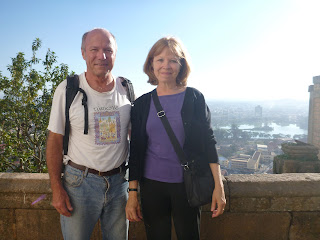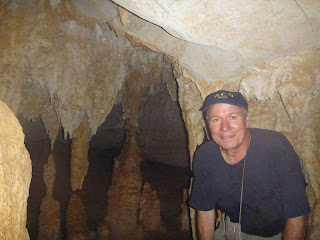 We arrived in Tana (what those in the know call Antanarivo)
on Independence Day, 26 June. People were celebrating 52 years of independence from France and there was a festive
air.
We arrived in Tana (what those in the know call Antanarivo)
on Independence Day, 26 June. People were celebrating 52 years of independence from France and there was a festive
air. |
| people gathering in a stadium for an Independence Day celebration |
The city has a European flavor mixed with Malaysia, where
many of its people migrated from some centuries ago. The view from the Queen’s Palace in Haute
Ville above the city was like Italy.
Madagascar is among the 50 poorest countries on the planet.
We are told not to walk at night and not use backpacks for fear of robbers. But we find people lovely--smiling, helpful, gracious. We do avoid traveling at night.
 We see our first lemurs at a lemur rehabilitation park just outside the
city. A bit lame for game viewing but handy for our introduction to lemur-dom. We get terrific close ups as
animals here have been rescued and are fed at regular times. There are common
brown, mongoose, crowned sifaka, black and white ruffled (my fav), Coquerel’s,
gray bamboo, black, and ring-tailed lemurs, the latter King Julien’s clan.
We see our first lemurs at a lemur rehabilitation park just outside the
city. A bit lame for game viewing but handy for our introduction to lemur-dom. We get terrific close ups as
animals here have been rescued and are fed at regular times. There are common
brown, mongoose, crowned sifaka, black and white ruffled (my fav), Coquerel’s,
gray bamboo, black, and ring-tailed lemurs, the latter King Julien’s clan.
We have a tasteful, comfortable hotel in the city. For
breakfast we sample, along with the croissants, a rice and greens stew--mine
plain, Tom’s with strips of zebu. He is looking forward to zebu steak and frites.
Zebu is a domestic, cow-like animal with a distinctive hump and interesting
horns. Ask K to see her zebu earrings...
Our first National Park is Andasibe, about 3 1/2 hours’
drive from the capital. The park area was bisected by a road built by the
Chinese in 1986, one side becoming the national park and the other a private
reserve. At dusk, as we head to the reserve for a night hike we are treated to
a well-timed road crossing by a group of common brown lemurs—between Tom and I.
Got them on video.
The night hike is all about watching for red eyes in trees.
Our guide is experienced and spots several nocturnal lemurs, the tiny mouse
lemur, sportive and wooly lemurs.
The national park is known for Indris, the largest lemurs.
We get to hear their morning vocalizations and eventually to see them as well. Indris cannot be moved or kept in a cage—they
stop eating and starve to death.
Along with the indris our guide points our various medicinal
plants, including: wild grape, from which tea is made from its leaves for
cardiac ailments; lantana, for hypertension;
and kabliflora, used to treat yellow fever.
And birds—we see: malachite kingfisher, velvet asity,
bulbul, paradise flychatcher, speckled green bul and blue koa. We are not birder people but it is interesting seeing all the variety.
We learn that the government had turned a swath of primary
forest 24 kilometers away into a cobalt mine, after moving a whole group of
diadem sifaka lemurs, the second largest species, to this park. Sometimes the sifakas and
indris fight.
The traveler’s palm is a national symbol. Its fan-like
fronds catch rain water and can be easily tapped to nourish thirsty travellers.
Returning to Tana from Andasibe, we take local transport. A
14 passenger van, already full when we get on, stops to pick up all who wish a
ride. I count 26…3 hanging out the open back door. The roof carries, among
other things, large bags of rice, our small backpack, and three bicycles. A lady leaves the bus and gives me her seat;
another comes on and I offer to hold her baby. When she gets a seat she offers
to take the baby back but I indicate that I am fine, he is falling asleep. He
naps for the rest of the trip. Sweet.
Assorted notes:
- · zebu yogurt—rich!
- · The flag of Madagascar is white, red and green: white for purity, red for heart, and green for hope
- · Lonely Planet (four years old) says that no one speaks English in Madagascar—not true! Fascinating how that could change so in four years. We have no trouble getting English-speaking guides in the parks—most of them self-taught, and two of them who also speak self-taught Italian
- · Ebony trees grow one meter (yard) in 10 years
- · There are no poisonous snakes in Madagascar (unlike mainland Africa!)
- · K notes an Azerbaijan-Madagascar ex-colonial country similarity: both kept the shape of cap of their respective former police forces, Madagascar’s looking positively Parisian and Azerbaijan’s if anything an exaggerated Soviet shape. Shapes that connote power.
We fly to Diego Suarez, AKA Antsiranana, in the north. A bit glad we did not notice the luggage tags
until we had safely arrived.
We travel 108 kilometers (67 miles) on a truly horrendous
road, 3 ½ hours, to our second park, Ankaranana. The pavement had degraded to an irregular
patchwork. We had opted for a car and driver rather than try to negotiate a taxi brousse (“brush taxi”/public van or
pickup with benches). We think we may have way overpaid for the luxury of this
much traveled vehicle (we can see the road through a few holes in the floor),
but imagining the bumps in a crowded van, we are glad.
Lovely hiking in Ankarana. Highlights included the dramatic tsingy—limestone formations, a cave, a
500 year old ficus tree and a 600 year old baobab.
We stay the night just outside the park in a basic but clean
and nicely done place with mosquito net, marveling at the stars. We think we
spot the Southern Cross.
Next, a cushy French hotel on a bay outside Diego Suarez and
a little relaxation. The next day we walk up the hill behind the hotel, admire
the view of the bay, walk through a village and hail a tuk-tuk to take us
into town for a little shopping, after which we board public transport--the
rear of a pick up truck--to Ramena beach. Everyone smiles and laughs when the
driver stops to pick up yet one more person, bringing the number to 26 in the course
of the 45 minute drive: 6 on each of two benches, 4 on the floor, 3
in front with the driver, and 5 hanging off the back. A young man who collects
payment from riders wears a t-shirt that says
“ Luther College Senior Week 2012.”
Ramena is a beautiful sleepy beach village, with a number of modest tourist guesthouses. We stop at one of many small cafés along the beach. T orders a beer, K a rum arrangé or flavored rum, this one banana. We are startled to see a brown lemur jump up on a chair at our table. Apparently he is a regular fixture. It becomes clear that he is very interested in K’s rum.
Ramena is a beautiful sleepy beach village, with a number of modest tourist guesthouses. We stop at one of many small cafés along the beach. T orders a beer, K a rum arrangé or flavored rum, this one banana. We are startled to see a brown lemur jump up on a chair at our table. Apparently he is a regular fixture. It becomes clear that he is very interested in K’s rum.


We pour a small amount in a saucer on the table and he happily laps it up. Later he has climbed to a perch above a doorway and has a snooze.
We have noticed in many hotels, some businesses and public
areas posters decrying sexual tourism and warning that sex with minors is a
crime. Indeed we have seen many French men, mostly 50s, 60s, with striking
young Malagasy women. It is such a poor place. So sad.
We leave Madagascar charmed and intrigued.
Our return route is Antanarivo -Nairobi; Nairobi -Dubai; and
Dubai – Baku. We have a long layover in Dubai and have planned to go into town.
As we touch down, at 1:30 a.m., the pilot announces that the temperature is 34°
C--94°F! Dubai airport sports large fake palm trees
and carpet patterned to look like ridges of sand.













No comments:
Post a Comment